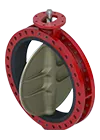More Details
Features & Benefits

-
A. Blow-out Proof Stem
A retaining ring, installed between the machined stem groove and gland retainer step, provides full retention of the stem in the unlikely event of internal stem failure.
-
B. Adjustable Packing System
Design allows for field adjustment of stem packing without removing manual operators or power actuators. The advanced, self-adjusting V-Type stem packing prevents external substances from entering the upper stem bore.
-
C. Primary & Secondary Seals
These seals prevent line media from coming in contact with the stem or body. Primary Seal is achieved by an interference fit of the molded seat flat with the disc hub. Secondary Seal is created because the stem diameter is greater than the diameter of the seat stem hole.
-
D. Stem Bearings
To absorb actuator side thrust and minimize bearing friction torque, upper and lower heavy wall sleeve bearings are utilized.
-
E. Vertical Thrust Bearing
A bronze vertical thrust bearing eliminates disc displacement due to the weight of the stem and disc.
-
F. Body
One piece full flanged style. All bodies are drilled to be compatible with ASME 125/150, PN10, PN16 or other international flange standards. Wafer style bodies are also available.
-
G. Disc
High strength discs are first cast, the sealing edges are spherically machined then either hand polished or the entire disc is Nylon 11 coated. The symmetrical disc profile increases generic flow coefficient values,reduces turbulence and increases pressure recovery.
-
H. Seat
The replaceable tongue and groove seat to body retention method is the most advanced design in the industry. Molded O-ring eliminates the requirement of flange gaskets. The seat isolates the valve body and stem from line media and has been specifically designed to seal with slip-on or weld-neck flanges.
Explore More Bray Insights
Learn Even More About How Bray’s Solutions Can Impact Your Business















